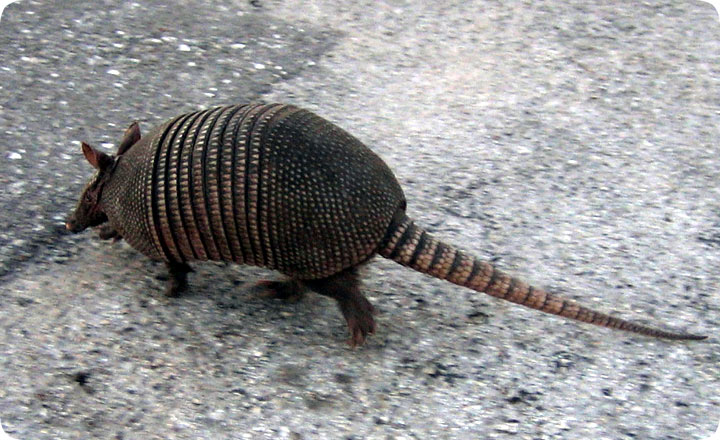-
info@aaanimalcontrol.com
Call us for help in your town
Humane Wildlife Education
The Nine-Banded Florida Armadillo

Since I've already explained why the armadillo is so danged different from the other animals (the shell, the leprosy, the identical quadruplets, the membership in the rare animal kingdom order Xenarthra, etc), I'll discuss the specific history of the Nine-Banded armadillo with the state of Florida. First of all, they're not native to the state. They come from Central America. It's believed that they were introduced to Florida when a breeding pair escaped from a south Florida zoo. They tunneled their way out. Other legends say that the Spaniards, in their lust for gold, named this creature "Little Armored One" and released them in Florida and Louisiana to try to dig up gold. Still other folk say that they merely made their way from Mexico and Texas to Florida in the 1960's, most of them in a brightly colored VW van.
I tend to think, that as with all animal introductions, various people, for various unknown reasons, carried them here, and released them for still more unknown reasons. That's how it usually seems to go. Anyway, they love Florida. There's like, 8 million of 'em in the state. They like the sandy soil, which is easy to dig in, much easier than blacktop. They like the warm weather, but if it's too hot, they only come out at night. In the winter, you can see them active during the daytime. This March 13th day was chilly, so I guess that's why it was out and about.
Do it yourself: Visit my How To Get Rid of Armadillos page for tips and advice.
Get professional help: Visit my Nationwide Pro Directory of wildlife removal experts.
For more wildlife stories, click my Wildlife Blog or click my below banner to hire a local trapper.

There are a lot of armadillo species found all around the world. However, there is only one that is found only in the United States. This is the “nine-banded armadillo”.
After first being introduced in Florida, the specie has continued to spread throughout the north and east of the U.S. Being an uncommon wildlife animal, there aren’t that many predators for the animal. Because of this, they are able to expand faster across the states.
Appearance
With armadillos, it is custom for them to have a shell that acts like armor-plates covering their bodies. Nine-banded armadillos, despite their name, have up to 11 bands on them. They can grow as long as 2.5 feet from the tip of their noses to their tails, and averagely weigh about 12 pounds or 5 kilograms.
Diet
Although the nine-banded armadillo appears as a tough creature, they aren’t exactly the type to attack bigger animals. In fact, they are mostly insectivores. Most of their meals consist of grubs, beetles, termites, worms, and occasionally some small reptiles, fungi, seeds, and other plant matter.
When they scavenge for their food, they will often push their snouts into the soil and dig around the area. They use their sense of smell to track down food.
Behavior
Nine-banded armadillos are rather solitary and don’t live in groups of many. They are also nocturnal, which means they are much livelier during the night time rather than during the day.
Their burrows, which they use as their homes, are typically 8 inches wide, 7 feet deep and 25 feet long. One thing that is quite unexpected about armadillos is that they will usually mark their territories.
Reproduction
Their mating period is usually some time from July to August when they are in the northern hemisphere, but November to January when they are in the southern hemisphere.
It starts with a single egg, which then splits into four identical embryos. As a result, the nine-banded armadillo gives birth to genetically identical quadruplets.
After their birth, the babies will remain in the burrow and drink their mother’s milk for up to three months. They will then tag along with their parent to hunt for meals and leave to live on their own after six months to a year.
Facts About the Nine-Banded Armadillo
Most people assume that armadillos can naturally roll up into a ball. But in truth, this is a common misconception. There are only two armadillo species that are capable of doing this, both being three-banded armadillos.
They can also jump up to 3 to 4 feet in the air when they get surprised or scared. Although this can be rather dangerous for them because it can cause cars to hit them when they cross the road. This is because they are small enough to simply pass by and are unnoticed when they are on the road.




















